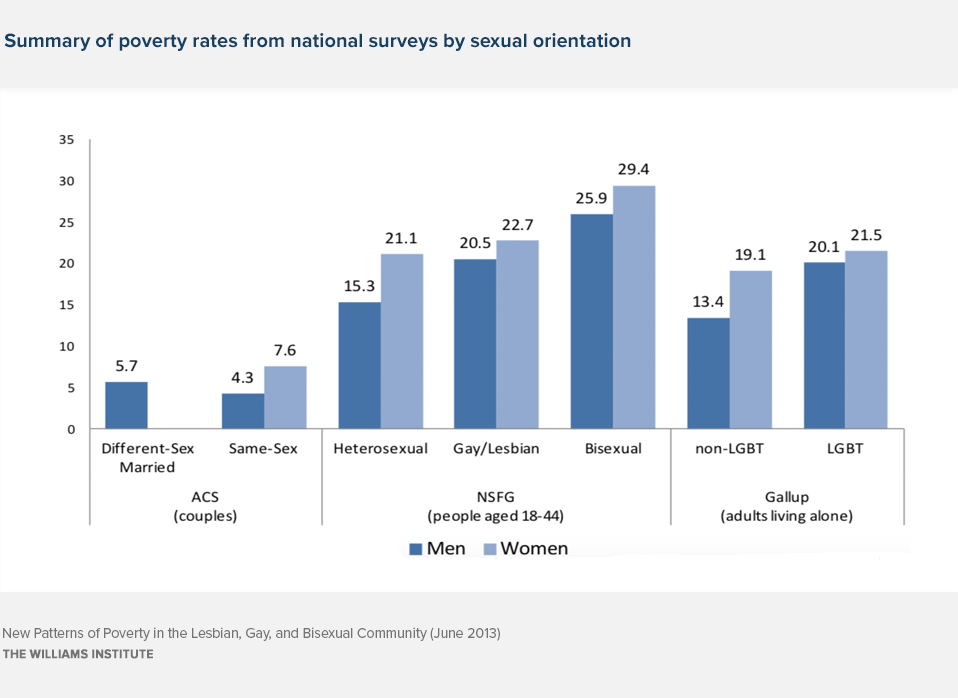Executive Summary
A severe global recession has brought heightened attention to poverty in the United States as the poverty rate rose over time, leveling off at 15.0% in 2011. Recent U.S. Census Bureau data demonstrates the persistence of higher poverty rates for African Americans, Latinos, Asian Americans, children, single mothers, people with disabilities, and other groups, for example. An earlier Williams Institute study and other research showed that lesbian, gay, and bisexual (LGB) people were also more vulnerable to being poor, and this study updates and extends that earlier report.
This study draws on recent data from four datasets to estimate recent poverty rates for LGB people in all walks of life: same-sex couples (2010 American Community Survey), LGB people aged 18-44 (2006-2010 National Survey of Family Growth), LGB adults in California (2007-2009 California Health Interview Survey) and single LGBT-identified adults (2012 Gallup Daily Tracking Poll). We compare the LGB or LGBT (including transgender people) rates to poverty rates for heterosexual people.
Data on couples suggests that same-sex couples are more vulnerable to poverty in general than are different-sex married couples.
- Poverty rates for female same-sex couples and unmarried different-sex couples were higher than those of married different-sex couples.
- While male same-sex couples have lower overall poverty rates than married different-sex couples, male couples were more likely to be poor than married different-sex couples after controlling for other characteristics that influence poverty.
Comparisons of poverty for LGB adults and heterosexual adults in national surveys mostly showed higher rates of LGB poverty, although most of those differences are not statistically significant.
- Among women 18-44 years old, more than a quarter of bisexual women are poor (29.4%) and more than 1 in 5 lesbians are in poverty (22.7%), a rate higher than the poverty rate among heterosexual women (21.1%), but the differences were not statistically significant.
- Similarly, a greater percentage of gay (20.5%) and bisexual men (25.9%) fell at or below the federal poverty line than heterosexual men (15.3%), but these differences were also not statistically significant.
- For both women and men in the Gallup data, one in five LGBT people who live alone report an income at or below the poverty level. The poverty rate for heterosexual people living alone is lower, although the difference is only statistically significant for men.
The poverty rates for lesbian and gay adults in California are lower than for heterosexual people and bisexual people in the CHIS data.
- This finding is likely related to the social and policy context for LGB people in California, since poverty rates for same-sex couples in California are also lower than for different-sex married couples.
- The California context could include greater acceptance of LGB people, less discrimination in family policy, less employment discrimination, and perhaps more supportive LGB communities in the state’s large metropolitan areas, all of which might help keep relative poverty lower.
Poverty rates have increased for LGB and heterosexual people over the recession that began in 2008.
While children generally have higher rates of poverty than adults, children of LGB parents are especially vulnerable to poverty.
- Children in same-sex couple households are almost twice as likely to be poor as in married different-sex couple households.
- White, Asian, and Hispanic children living in households headed by same-sex couples do not have significantly higher poverty rates than children in different-sex married households.
- African American children in gay male households have the highest poverty rate (52.3%) of any children in any household type, and the rate for children living with lesbian couples is 37.7%.
- This poverty gap is highest for children aged 0-5 who live with same-sex couples.
Poverty rates are higher for certain subgroups of same-sex couples.
- African Americans in same-sex couples have poverty rates at least twice the rate for different-sex married African Americans. African American men in same-sex couples are more than six times more likely to be poor than White men in same-sex couples, and African American women with female partners are three times more likely to be poor than are White women with female partners. The difference in poverty rates for black and white couples is disproportionately higher in same-sex compared to different-sex couples.
- Poverty rates for women in same-sex couples are higher than married couples’ rates in the central part of the United States, in New England, and outside of large metropolitan areas.
- Poverty rates for men in same-sex couples are much lower in large metropolitan areas than rates for married different-sex couples.
- Low levels of education tend to increase poverty more for women in same-sex couples than for men.
- Women in same-sex couples are more likely to be among the “working poor,” with higher poverty rates than for men in same-sex couples or different-sex married couples.
- Women in same-sex couples who have a disability are more likely to be poor.
Low-income LGB people and same-sex couples are more likely to be receiving cash assistance and SNAP (food stamps) benefits than are heterosexual people or couples. The figures for individuals are not all statistically significant, however.
Poverty rates are lower for female same-sex couples in states with marriage equality or civil unions and in states that outlaw employment discrimination based on sexual orientation. However, those differences are not statistically significant in more detailed analyses. We also find that poverty rates are lower for all couples in states with those policies.
Download the full report
